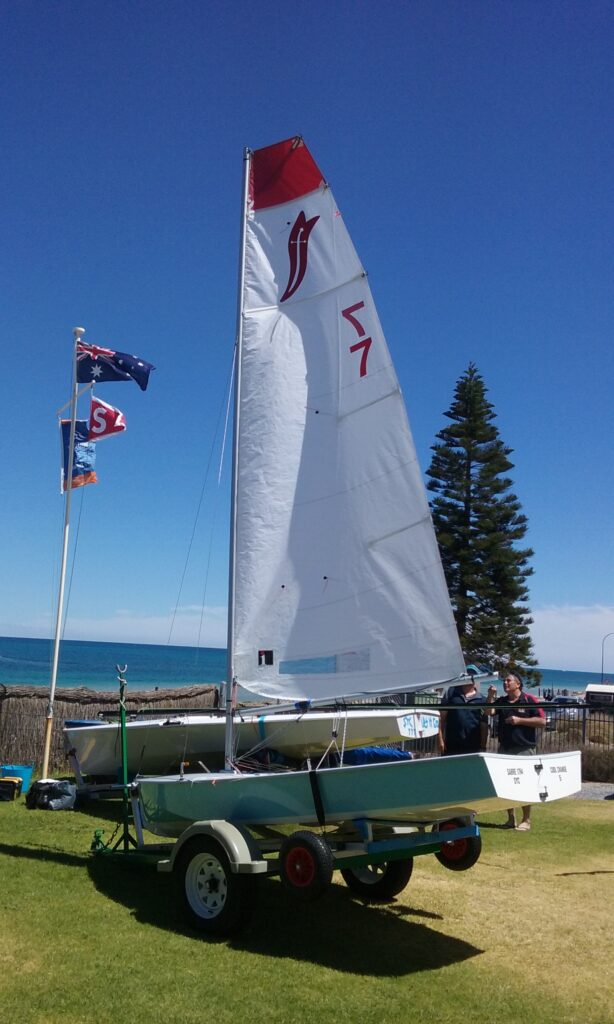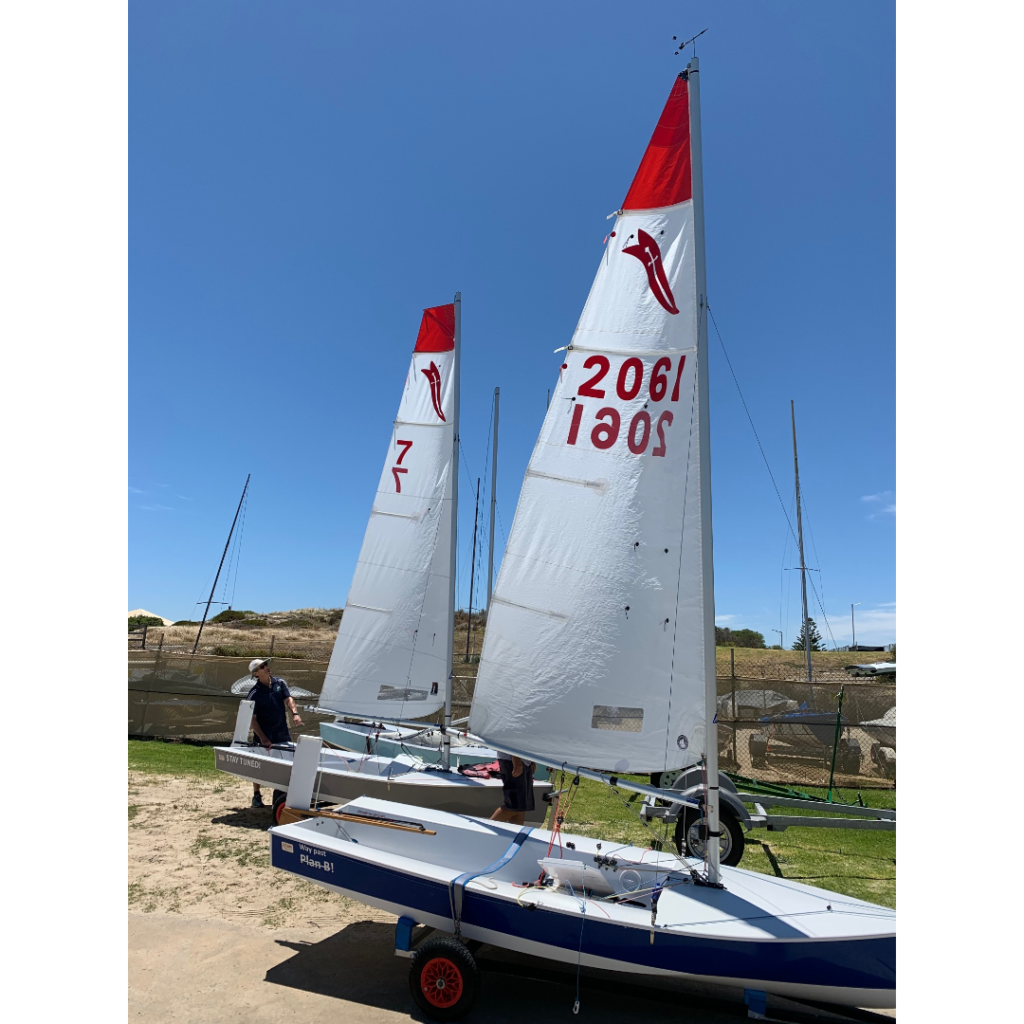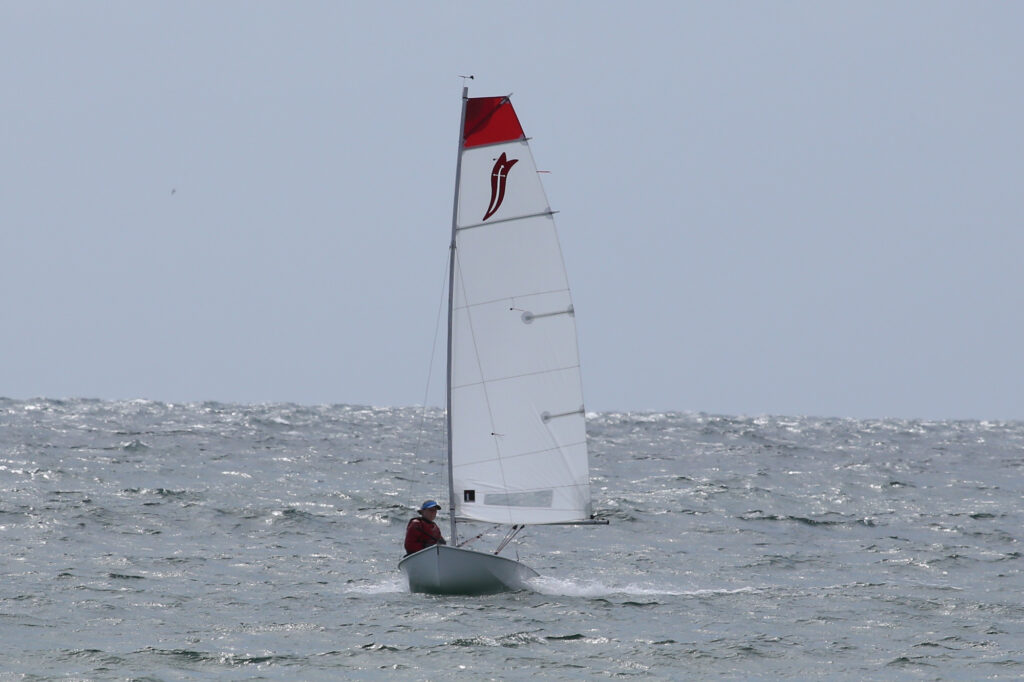AUGUST 2021 WRAP-UP
Introduction
For the almost 50 years history of the class, although having strict measurement rules, it has always been open to rule amendments particularly those incorporating improvements in building techniques and materials. With expert input, these amendments have been discussed and decided by the Sabre Sailing Association of Australia (SSAA) which is comprised of representatives from all states.
For two years, Sabres trialled a new sail design. It involved extensive sailing in different wind, wave and crew conditions around Australia. Individual reports on each trial were received and a survey of participants and other interested Sabre sailors was undertaken by SSAA. The progress of the trials was advised to Sabres sailors by Mail Chimp emails, Facebook and on the Sabre website.
Whilst the trial design was well received, in mid 2021 SSAA unanimously agreed that there was insufficient support from current sailors to warrant a change. Hence the current well recognised sail will continue to power the Sabre for the foreseeable future.
We expect that all Sabre sailors will respect this decision which was reached after considerable effort and input by many in our Sabre fleets in Australia. In addition, thanks to those volunteers who put so many hours into the guidance, logistics and analysis of the project.
Feedback behind the SSAA decision.
Based on feedback we received from the trials and survey of sailors, there were several different bodies of opinion and we’ll try to summarise them.
- New sail – apparent modernisation and speed.
- Let’s show that we have ‘modernised’ and are not stuck in the past.
- A new sail can slightly increase the Sabre’s speed and pointing ability, particularly in light to moderate conditions.
- We feel that the slight sail area increase will not significantly affect our current Sabre cohort.
- The change should help to bring in some new sailors.
- Current sail – status quo.
- We have a very popular class that continues to grow. It has attracted a broad group of sailors and we don’t want to shake up a successful formula. Why do we need to have the disruption and cost of change?
- The Sabre is often the only class that can successfully race in 20 plus knots and large seas, conditions that often occur in the southern states of Australia. Let’s not risk losing this capability.
- We have received feedback that some sailors believe that the increased area at the top of the sail will make the boat less stable on a square run in strong breezes. If so, this may put some current sailors off wanting to sail Sabres.
- Adoption of the trial sail may mean that a stiffer mast may be needed and it might also affect other parts of the boat.
- It’s likely that the trial sail will cause the fleet to spread out more and this goes against our desire to have close competition throughout the fleet.
In addition, the survey showed some 20% of respondents were indifferent to the result.
What we have learned from the Sail Evaluation Project.
The project has been running for almost two years. During this time it has been progressively refined and we have learnt some useful things. In future times, the following may be useful for those considering significant changes in the class.
- Use a small team to run the project with input from a range of current sailors
- Specify the boundaries at the outset, eg not to disadvantage your current cohort.
- Understand what you are seeking to achieve.
- Accept that to do it properly, eg getting inputs from all around Australia, the process will take considerable time. There will be people pushing for a rapid result, particularly their preferred option.
- Be clear that if there were to be a change, it would be implemented in a time frame that would have minimal disadvantage to those with the current set up.
- Settle on a design in the early stages, trial against the current situation, eg the sail, in various conditions, document the results and learn from them.
- Communicate progress regularly.
- Understand you can’t please everyone. There will be those who see the project as an opportunity to satisfy their own agendas.
- Survey current sailors and set the parameter for acceptability.
- Decide to change or not according to the class rules and governance
- Communicate the decision and reasons why it has been reached. Which is what we are now doing!
It has been an interesting project, one with lots of twists and turns and has provided our Sabre sailors with a good opportunity to be involved in a major decision. We look forward to next season which again has its challenges due to the ever present covid threat. Meanwhile, it is great to see the continuing growth of the class, all the best and enjoy your Sabre sailing.
Russell Rooney,
President,
Sabre Sailing Assoc of Australia.
JULY 2021 UPDATE
Time has elapsed since February when we last reported on this topic. Since then, the trial sails have completed their travels around all states. A survey form was sent to all Sabre contacts on our database and responses were received and analysed. The responses included a wide range of often diverging comments.
The survey, together with the feedback sheets from those who trialled the sail, informed your State Sabre Sailing Association of Australia representatives. We attach a summary sheet of the survey feedback. The SSAA recently met to reach a decision on the future of the evaluation.
In essence, SSAA decided unanimously that although there was positive comment about the trial sail and useful feedback on small improvements to it, there was insufficient support from current sailors to make a change to a new design.
Our time and effort was certainly not wasted; it has provided a body of information on sail behaviour and design should there be any moves in the longer term. It also showed how the fleet around Australia can work together to achieve an outcome.
As a successful one design fleet our strengths include the inclusive nature of the class, the wide range of sailors who sail and the close racing that we have at club, state and national levels. It’s a great position on which to build.
SAIL EVALUATION SURVEY – SUMMARY RESULTS
FEBRUARY 2021 UPDATE

The evaluations in Tassie and South Australia are almost complete, delayed a little by the Xmas, New Year holiday break and the usual uncooperative winds. It’s good and perhaps not surprising to hear that comments have been positive in the varied sailing conditions, sailor weights and experience.
Those who have used the sail and filled out the evaluation sheets have approached the trial with an open mind and enthusiastically. So far the trials reaffirm the Sabre approach as an affordable one design dinghy, willing to consider contemporary materials and design developments, provided they don’t disadvantage our current range of sailors and their boats.
The comments section of the forms has given us some thoughts which may lead to minor tweaks in the sail design, yet too early to reach any conclusions.
The abovementioned two sails will be sent to NSW and Qld in early March.
We had planned to continue the movement of a sail around the clubs in Victoria and to have some discussions at the Vic State Championships (80 registered starters!) to be held at McCrae 13,14 February. Unfortunately, this was postponed less than 24 hours from the start due to a State Government stage 4 lockdown of Victoria and will now be run 6,7 March 2021. Entries have now been reopened, closing 8pm Friday 5 March.
Thus despite a few hiccups, the evaluation process continues to be on track to complete towards the end of the 2020/21 sailing season. It would then require serious discussion and consideration if any change from the present sail were to be made and if so, a lengthy introduction period would be required.

DECEMBER 2020 UPDATE

The three identical copies of the development Sabre sail are now being trialed in WA, Tassie and in the peninsula clubs in Vic. So far the feedback has been positive, encouraging SSAA to progressively move them around to other states as they become available. Indeed, the sail in WA is now about to move to SA and the sail in Tassie will move to NSW, next to Qld. In other words, the trial is on track to complete at the end of this corona virus affected sailing season.
We want to ensure the trials are as transparent and objective as possible, and to achieve this, an evaluation sheet is given to each sailor. It should be emphasized that the focus of the trials is on an efficient and attractive sail that will best cover the criteria below; not necessarily the fastest in specific conditions, bearing in mind that all boats will have the same maximum sail outline.
The evaluation sail design follows the criteria established a year ago covering sail efficiency and appearance, cost, safety, ability to be produced with varying fullness to suit crew weights, sailing conditions and experience and especially not disadvantaging our current fleet of Sabre sailors.
Here are recent comments from Perth trials. ‘On the water the trials have consisted of a combination of 2 boat testing together with in race testing by a range of sailors both male and female ranging in weight from 58kg to 90+kg. Wind and water conditions ranged from 5-10 knots and flat water to 18-25 knots with steep, short chop.
- Straight line speed was slightly better than the standard sail on all points of sailing with the greatest improvement in speed in the 8 to 15 knot range.
- In choppy conditions the boat seems to power through the waves more easily with the trial sail.
- The ease of sailing upwind in gusty and or fresh breezes was noted by several sailors. It required less working of the mainsheet due to the sail top providing better gust response than the standard sail.
- Generally, sailors noted that they found the sail as easy to use as the standard sail.
One of our lady sailors used it in 18-23 knots and was impressed with its ease of handling and gust response.’
It’s worth repeating that should there be a change to the existing Sabre sail, the process is likely to take several years to ensure that those people now purchasing a new Sabre sail would not be disadvantaged.
It’s also critical that our highly valued friendly and inclusive Sabre culture which has been a significant factor in attracting us to the class, not be jeopardized in the evaluation process. At the outset of this journey, it was agreed that the last thing we needed was the move to a split class, each with a different sail. Our survey of Sabre sailors conducted in mid 2017 made it clear that this was the case. Our broad demographic of sailors is attracted to the Sabre for the ability to compete in well patronized and run State and National one class regattas and strong, inclusive Sabre club fleets spread around Australia. We want to keep it that way.
OCTOBER 2020 UPDATE
Hello Sabre Sailors,
Trust you are all well and coping with this new world of COVID. The sailing season appeared to be showing signs of promise here in Victoria but unfortunately the various collective and individual efforts of parties known and apparently ‘unknown’ to our bureaucrats, mean we are still working through to ‘the path to reopening Victoria’- whatever that means.
There are several important areas that this communication covers, including aspects of the Sabre sail evaluation process. In April 2019, the incoming SSAA Committee made a commitment that the SSAA would undertake several things regarding the sail evaluation process and the challenges to the class:
- The SSAA served notice that it intends to conduct its affairs into this matter with integrity, impartiality, professionalism, and objectively.
- We will carry out our duties in accordance with the General Principles of the Constitution of both the SSAA and the Constitution of Australian Sailing.
– Violation or breech of these policy documents will be a matter for referral to Australian Sailing.
– The SSAA will be transparent in its processes and communicate periodically.
– The SSAA will adopt a zero-tolerance approach to breeches of the above.
It is our intention to honour those statements. For completeness we reinforce that all this information has been previously communicated by email and on the website in June, September 2019, February, April, September 2020.
The Current Legal Sabre Sail
While this appears to be a case of the bleeding obvious, there is only one legal Sabre sail design. The current design is as prescribed in the class rules. The Sail evaluation process is continuing its development and is commented on below. In the interim we re-affirm the following
- The current legal Sabre Sail is as specified in the Sabre Class rules
- No alternative sails are Class legal
- This represents that the use of illegal class sails on a Sabre does not constitute a legal Sabre.
- Racing of Sabres by any Club, Association or Organisation when using illegal sail designs is not a legal Sabre race event and is not legally supported by the SSAA.
- We are engaging with Australian Sailing to seek further clarification on the legal, liability and insurance aspects of the Sabres being raced with an illegal sail design.
- We will also be formally communicating to all Sabre sailing clubs on this matter to directly express this position
- There are seven Facebook pages that support and reflect the SSAA legal Sabre
- These are the Sabre Performance Forum (link from www.sabre.org.au)
- Sabre Sailing Associations of VIC, WA, Tas, NSW, SA, Qld
- There exists a page on Facebook called the ‘Sabre Dinghy Owners Group’ which promotes the use of the so called Shark sail. This page does not support the views or positions of the SSAA, nor is it supported by the SSAA. SSAA holds registered intellectual property rights covering various Sabre logos including the red logo, certain profiles, and the Sabre itself. Use of the red logo on non-legal sail designs breaches those IP registrations.
- We will revert these matters to Australian Sailing and potentially to our legal Trademark partner for their input.
Sail Evaluation Process
We point out and reinforce previous communications regarding the Sail Evaluation as there have been several enquiries as to the intent and criteria of the process. We emphasize the key components and decisions to date regarding the sail evaluation
- NO decision on a new sail design being adopted by the SSAA is mandated.
- A recommendation will be made once the sail evaluation is completed
- The Criteria for the Sail Evaluation are on the Website; the key elements of the criteria are
- Not to materially disadvantage the current Sabre sailing demographic
- Maintain Class identity
- Promote improved sail efficiency and aesthetics
- Improve safety, maintain durability, and be cost effective
The sail evaluation process is well underway and if were not for COVID restrictions it may well have been completed. To accelerate the process two additional Concept sails have been manufactured to facilitate testing in other states. In early October, one is being evaluated in Perth, another will shortly be despatched to Tasmania and the third will continue to be tested in Victoria before being sent to other states. Currently there are several aspects that the sail evaluation process has revealed:
- The original Shark sail was a useful basis to assist the Sail Evaluation Team and provide some initial thoughts around the sail evaluation concept.
- The Shark sail has been reviewed but considered inappropriate and unsuitable for the Sabre due to several factors including performance, sail area, design, and aesthetics and has been excluded from further evaluation by the Sail Evaluation Team (SET).
- Compared to the current Sabre sail, the current concept sail demonstrates improved performance in light, medium winds, similar performance and sailing ability requirements in stronger winds, improved efficiency, and safety with a larger window.
To recap, the sail evaluation process is well advanced but is not complete and once further testing allows, will be concluded and a report compiled. Finally, should any decision be made to introduce the new sail design then this would be carried out over a period to allow all competitors to enjoy the use of their current Sabre sail for its competitive life.
Yours in Sailing,
The SSAA Committee
